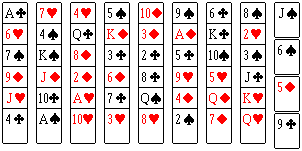Twelves Solitaire Rules
12's is a solitaire card game created by Randy Rasa for use in his Simple Pleasures collection. It is part of the "simple addition" family of solitaires, which includes games such as Pyramid, Fifteens, and Elevens. This game is somewhat reminiscent of a traditional solitaire called "Fourteen Puzzle", but has a unique flavor all its own.
Setup
The game is begun by dealing the cards into eight piles of six cards each, with the remaining four cards in single-card piles of their own. All cards are dealt face-up. Any card that is completely exposed (i.e. the top card of each pile) is available for play. An example layout is shown below:

The object of the game is to remove pairs of cards that add up to 12, regardless of suit or color. Number cards count their face value, and Jacks count as 11. Kings and Queens are removed in pairs. Here are all the possible pairs:

In the layout above, there are a number of plays which are immediately evident:
- The 4 of clubs and the 8 of hearts.
- The ace of spades and the jack of spases.
- The 10 of hearts and the 2 of spades.
- The 3 of hearts and the 9 of clubs.
- The 7 of diamonds and the 5 of diamonds.
Removing those cards will expose new cards, creating more possible moves. Continue removing cards until either no more moves are possible, or you win the game by removing all the cards from the tableau.
Strategy
This is one of those games where you get the feeling that darn near every hand can be won, with sufficient patience and foresight. Taking the time to study the tableau before beginning play can help immeasurably in finding and working around potential blocks. Some of the "gotcha's" to watch out for are:
Pairs in the same pile: In the example above, the A-J, 6-7, and 9-4 in the first pile are all potential stumbling blocks. You'll have to use cards from other piles to create the pairs.
6's: None show up in the example above, but often, two or more 6's will end up in the same pile. This is a problem similar to the previous one, but made worse because there are only two pairs (rather that the four with all other combinations). And if you happen to get three 6's in one pile, you might as well give it up right there -- the hand is impossible.
Bottom cards: If three or four of a single card (for example, Q's) are on the bottom of the piles, and their mates (in this case, K's) are on the tops, you've got trouble.
Criss-Crosses: Watch out for situations where cards from one pair are mixed up with cards from another. An example occurs in the example above, where the Q-8 in column three is criss-crossed with the 5-K in column four. This situation is usually not difficult to work around, but you have to be alert for it.
Once you've determined that the hand is potentially winnable (or, at least, not impossible), start removing pairs. The following guidelines seem to help:
Try to keep all the piles as nearly even as possible.
Use the four "extra" cards on the right only as a last resort. Since removing one of those cards does not uncover any new cards, you've traded a short-term gain for long-term pain.
Likewise, there is no advantage to removing all the cards in a pile, if other piles still have playable cards.
Odds
Your chances of winning are about one out of every three or four games. Here are my current statistics:
- Games Played: 294
- Games Won: 61 (30.61%)
- Average Score: 33.42
(I generally ignore all the above advice, rushing headlong into a hand without looking too far ahead, and my stats reflect my hasty ways. If I only took the time to plan out my strategy, I think it would be possible to win much more often. Oh well ...)
The rules to this game are copyright Randy Rasa, and neither the rules nor the game they describe may be reproduced without written permission.

